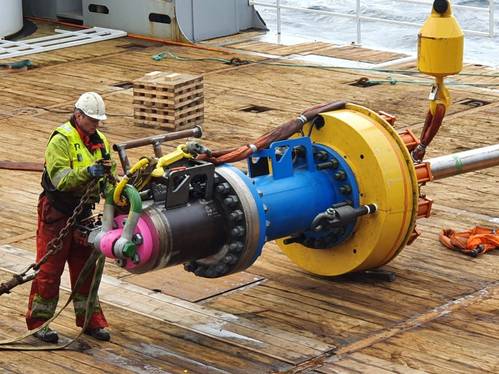Baker Hughes Launches Subsea Wellhead Cutting System "Terminator"
Oilfield services company Baker Hughes has launched a vessel-deployed subsea wellhead cutting system called the Terminator.
In what Baker Hughes says is "a first-of-its-kind mechanical wellhead removal method", the Terminator system has already been used to cut a subsea wellhead from an abandoned exploration well owned by Wintershall DEA in Norway.
Romain Chambault, Europe vice president for oilfield equipment at Baker Hughes said: "In the current environment, every aspect of operations is under the spotlight. We see unavoidable costs for our customers, like wellhead removal, as opportunities to build new efficiencies into operations.”
"The Terminator system is a game-changer for our industry, saving time, costs and fuel consumption to improve operators’ efficiencies and their carbon footprint," he says.
According to Baker Hughes, the cutting of the subsea wellhead from an abandoned exploration well at the WintershalL DEA project was conducted in a water depth of 360 meters and took only 35 minutes.
By comparison, the company says, alternative abrasive cutting methods could take as long as five or six hours for the cut alone.
Fewer people required
"The Terminator system can be deployed from a vessel and uses a mechanical cutter, rather than water jet cutting methods of conventional systems, to eliminate associated risks with high pressures. In addition, the system can reduce offshore personnel by two-thirds compared to conventional systems, requiring just two people instead of the typical six for water cutters," Baker Hughes explains.
Apart from needing fewer people, Baker Hughes says the Terminator system can also reduce fuel consumption with its 100-horsepower motor and is also smaller and lighter compared to the original 1000-horsepower abrasive water cutting system typically used on similar types of vessel-based operations.
Tore Oian, Drilling Manager for Wintershall DEA explains why the company opted for the Terminator: "While working with Baker Hughes on this project, we selected the Terminator system because of the lower CO2 impact it had on the environment”
"In addition, the solution required a minimum amount of deck space and only needed a crew of two people which gave us much more flexibility when selecting the vessel and reduced the mobilization time, considerably. Altogether, this was the best technical, environmental and economical solution for our operation.”
The total operation with Wintershall DEA, from deck deployment to laying down the Terminator system, took two and a half hours.
This, BH said, saved the operator up to 12 hours compared to conventional systems. After the cut was complete, the subsea wellhead, conductor and spudcan were removed immediately in a separate run from the same vessel.

















 August 2025
August 2025



